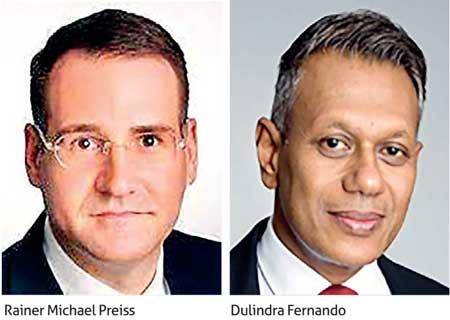Reply To:
Name - Reply Comment
By Nishel Fernando
The disposal of the state-owned enterprises (SOEs) presents the best option for Sri Lanka to avert a possible domestic debt restructuring (DDR) scenario, while it could become a catalyst to develop a vibrant capital market to exploit the current market opportunities, where the investors are rallying back to emerging and frontier markets.

Global investment advisor and asset management strategist Rainer Michael Preiss, who also serves as a Director of Colombo-based Ceylon Asset Management (CAM), along with the company’s Managing Director Dulindra Fernando, outlined that the sale of SOEs is the only viable alternative to achieve debt sustainability as demanded by the country’s external creditors and avoid a potential DDR that would have an adverse impact on the domestic banking and insurance sectors and superannuation funds.
While expressing their willingness for debt restructuring, the holders of Sri Lanka’s International Sovereign Bonds (ISBs) have put forward several conditions, which include maintaining the country’s annual gross financing needs at 13 percent of GDP for the 2027-2032 period, at the end of the proposed International Monetary Fund (IMF) programme.
Otherwise, they cautioned that the country might have to restructure its domestic debt, potentially with a combination of 30-50 percent haircut and a five-year reprofiling of external debt. According to the Finance Ministry, Sri Lanka’s gross financing needs were estimated to have reached 37.9 percent of GDP in 2022.
While acknowledging the progress made so far since the collapse of the economy in April, last year, Preiss emphasised that it’s crucial for the country to maintain its focus on economic discipline, instead of politics.
“With no end in sight of the Ukraine war and US-China tensions escalating, the world needs diplomacy from their leaders today. Meanwhile, Sri Lanka needs economic discipline to stay the course until its return to stability and regains the confidence of global investors,” he said.
Fernando opined that the government should be allowed to continue with its economic revival programme for another year.
In the secondary market, Sri Lanka’s 2030 ISB jumped by 40 percent to US $ 35.37 as of last week, from US $ 25.27 in October, last year. When Sri Lanka secures the final approval for the IMF bailout package, CAM expects the bond to trade above US $ 50 in the secondary market.
Preiss insisted that the on-going economic crisis should be viewed as an opportunity for a reset, which should not be wasted upon.
Buoyed by stronger growth prospects for emerging markets compared to developed markets this year, combined with abating inflation pressures, he highlighted emerging markets are projected to outperform developed markets this year.
“We expect this to continue. It could be a long-term trend,” he added.
In this context, he opined that SOE divestments would be one of the key ingredients to attract foreign inflows into the country’s equity market.
Historically, when emerging markets rally, frontier markets tend to overperform.
Underpinned by foreign investments into SOEs, both Fernando and Preiss opined that the economy may return to a growth trajectory this year. According to Bloomberg’s Contributor Composite, Sri Lanka’s GDP is expected to grow by 3 percent this year, despite the 3 percent and 4.2 percent economic contractions projected by the IMF and World Bank, respectively.
Preiss pointed out that SOE divestments were a key contributor to the UK 16-year economic boom that lasted from 1992 to 2008, which helped the country to shed the label ‘sick man of Europe’.
“Prior to the divestment, British Airways was even at a much worse condition than SriLankan Airlines,” he added.
CAM expects the rupee to stabilise at of Rs.350-400 against the US dollar, as the proceeds from the asset sales will be utilised to strengthen the country’s foreign exchange reverses.
Note: This story has been corrected. "...a combination of 30-50% haircut and a 5-year reprofiling” was in relation to external debt and not domestic debt.